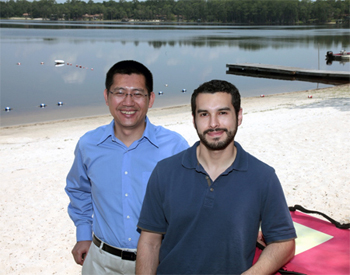 As a young scholar, Fernando Rios loved science and computer programming equally. So when Rios — who holds a bachelor’s degree in physics from Canada’s University of Waterloo — went looking for a graduate program, he discovered the Department of Scientific Computing at Florida State University, which has about 35 graduate students and launched a new undergraduate program of computational sciences in fall 2010.
As a young scholar, Fernando Rios loved science and computer programming equally. So when Rios — who holds a bachelor’s degree in physics from Canada’s University of Waterloo — went looking for a graduate program, he discovered the Department of Scientific Computing at Florida State University, which has about 35 graduate students and launched a new undergraduate program of computational sciences in fall 2010.
Now, along with his FSU professor and colleagues, Rios has written an important and practical software program that could protect Florida’s lakes and rivers from excessive pollutants.
Associate professor Ming Ye
& graduate student Fernando Rios
“I wanted to use both my science and computing skills at the same time, not just one or the other,”
Fernando Rios
Rios, along with associate professor of computational hydrology/geology Ming Ye, recently spent two and half years developing the software, which is designed to help local and state government measure the amount of nitrates from septic systems that end up in surface water bodies such as lakes and rivers.
“In Florida, there’s a lot of septic tank usage — and an increased potential for increased groundwater and surface contamination,”
Fernando Rios
Rios wrote the software known as ArcNLET (ArcGIS-Based Nitrate Load Estimation Toolkit).
“When the nitrates enter groundwater, they can end up in drinking water and surface water.” Fernando Rios
Nitrates in drinking water may cause a health disorder known as methemoglobinemia, which in newborns can manifest itself as a sometimes-fatal condition called “blue baby syndrome.” Discharge of nitrate-rich groundwater into surface waters also can lead to fish kills, algal growth, hypoxia, eutrophication (a bloom of phytoplankton), and outbreaks of toxic bacteria.
ArcNLET, which is free and available on Ye’s website, officially will debut at a training workshop on Friday, July 8, in the Geography Information Systems Laboratory in FSU’s Bellamy Building. The workshop is geared toward employees of state, local and county governments throughout Florida.
“Basically, we just want to introduce people to the software and give them an idea of what it can do.”
Fernando Rios
"The GIS-based model is easy to use and has a shallow learning curve,”
Ming Ye
Ye holds a doctorate in hydrology. In addition to his classes in scientific computing, he also teaches in Florida State’s Department of Earth, Ocean and Atmospheric Science.
"An average person can use this."
Ming Ye
Ye, who, together with Paul Lee and Rick Hicks of the Florida Department of Environmental Protection, developed the concepts and ideas behind the septic software model, specializes in predicting how contaminants in water affect human health. Approximately one-third of Florida’s population uses onsite sewage treatment and disposal systems — or septic systems — for treating domestic wastewater. Estimation of nitrate load from septic tanks to surface water bodies is critical to analysis of water resources and to environmental management. The ArcNLET software can estimate such nitrate loads.
The software research and development was funded with a two-year, $80,000 grant from the Florida Department of Environmental Protection, with an additional $60,000 extension of that grant. The development is also supported in part by the Florida Institute for Energy Systems, Economics and Sustainability at Florida State.
Rios, who is now studying geography in the doctoral program at the University at Buffalo, The State University of New York, has returned to FSU’s Department of Scientific Computing this summer for a paid internship, partly because he enjoys working with Ye and fellow FSU graduate students. He also is continuing his work on the ArcNLET software project.
“It’s basically a tool to help guide certain kinds of decision-making,”
Fernando Rios
Rios dreams of someday working as a government consultant doing environmental research on groundwater. He said he is proud of his work but adds that ultimately it’s not a panacea.
“No (computer) model will give you a definitive answer...
Fernando Rios
Basically, this is just another method to help guide decision-making.”
For more information on ArcNLET, visit Ye’s website or the home page of the FSU Department of Scientific Computing.
Original story from http://www.fsu.com/Featured-Stories/New-software-aids-fight-against-nitrates-in-Florida-s-groundwater


